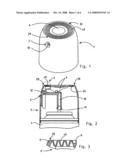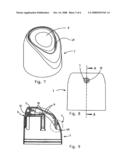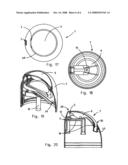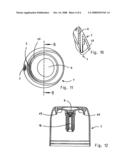Patent application title: Cap for an Aerosol Container or a Spray Container
Inventors:
Heiko Eberhardt (Oberursel, DE)
Franz Steigerwald (Griesheim, DE)
Robert Goetz (Frankfurt/main, DE)
Assignees:
WELLA AKTIENGESELLSCHAFT
IPC8 Class: AB65D8300FI
USPC Class:
22240213
Class name: Fluid pressure valve actuated by nozzle or through valve outlet with container end overcap having actuator
Publication date: 2008-10-16
Patent application number: 20080251543
Inventors list |
Agents list |
Assignees list |
List by place |
Classification tree browser |
Top 100 Inventors |
Top 100 Agents |
Top 100 Assignees |
Usenet FAQ Index |
Documents |
Other FAQs |
Patent application title: Cap for an Aerosol Container or a Spray Container
Inventors:
Heiko Eberhardt
Franz Steigerwald
Robert Goetz
Agents:
MICHAEL J. STRIKER
Assignees:
WELLA AKTIENGESELLSCHAFT
Origin: HUNTINGTON, NY US
IPC8 Class: AB65D8300FI
USPC Class:
22240213
Abstract:
In order to seal a spray cap acoustically, a cap 7 with a button 6 is
provided with an elastic connection 49 between the button 6 and the cap 7
so as to form an acoustic seal 49 of the cap 7. The seal 49 is designed
as a folded arrangement.Claims:
1. A cap (7) with a button (6) for actuating a valve of a container (1),
in particular of an aerosol container or spray container, the button (6)
being intended to act against a separate, angled connection piece, in
particular an angled spray channel (10), and thus against a stem (11) of
the container (1) in order to deflect the stem (11) upon manual actuation
of the button (6) and in order therefore to open the valve, as a result
of which a product contained in the container (1) can move out through
the stem (11) and through a product dispensing opening (3) provided on
the cap (7), in so doing passing through the spray channel (10), and a
flexible connection between the button (6) and the cap (7) forming an
acoustic seal (49) of the cap (7), wherein the seal (49) is designed as a
folded arrangement which is stretched when the button (6) is actuated and
which is returned into the original folded arrangement when the button
(6) moves back.
2. The cap as claimed in claim 1, wherein the button (6) is round, preferably circular or oval, and the seal (49) runs annularly around the button (6).
3. The cap as claimed in claim 1, wherein the seal (49) is designed as a bellows arrangement.
4. The cap as claimed in claim 1, wherein the seal (49) has a peripheral single fold.
5. The cap as claimed in claim 1, wherein the seal (49) is connected to the cap (7) and to the button (6) in a one-piece construction.
6. The cap as claimed in claim 1, wherein the seal (49) is designed as a separate component which can be inserted as a plug connection between the cap (7) and the button (6).
7. The cap as claimed in claim 1, wherein the button (6) is connected to the area (29) of the cap (7) via a hinge (5).
8. The cap as claimed in claim 1, wherein the seal (49) hermetically seals off the surface between the cap (7) and the button (6).
9. The cap as claimed in claim 1, wherein the spray channel (10) is designed as a spray angle which is connected to the cap (7) in the area of the product dispensing opening (3).
10. The cap as claimed in claim 9, wherein the material thickness of the seal (49) in the area (29) of the product dispensing opening (3) is less than the material thickness in the area (30) of the seal (49) farthest away from the product dispensing opening (3).
11. The cap as claimed in claim 2, wherein the material thickness of the seal (49) from the area (29) of the product dispensing opening (3) to the far area (30), continuously increases from 0 to 180 degrees and continuously decreases from 180 degrees to 360 degrees.
12. The cap as claimed in claim 10, wherein the material thickness of the seal (49) in the area (29) located at the product dispensing opening (3) is between 0.4 and 0.6 mm and, at the far area (30), it is between 0.1 and 0.2 mm.
13. The cap as claimed in claim 1, wherein the seal (49) is made of an elastic elastomer material, such as soft and flexible polypropylene (PP) or polyethylene (PE).
14. The cap as claimed in claim 1, wherein the cap (7) and seal (49) and button (6) are made in one piece from elastomer material.
15. The cap as claimed in claim 14, wherein the cap (7) is made of two-component elastomer.
Description:
[0001]The invention relates to a cap for a container, in particular an
aerosol container or a spray container, with a button for manual
actuation and for delivering a product present in the container, for
example a hair spray, from a product dispensing opening of the cap.
[0002]It is known, from WO 01/96210, to seal a cap of this kind in order to obtain a pleasant spraying sound while a product is being dispensed. The button acts against a stem (product dispensing tube) of the container via an angled spray channel in order to deflect the stem by manual actuation of the button and in order therefore to open a valve located in the container, as a result of which the product contained in the container moves out through the stem, the spray channel and a product dispensing opening provided on the cap. A flexible connection between the button and the cap provides for an acoustic sealing of the cap.
[0003]EP 0 669 268 A1 discloses a pivotable button which is formed in one piece with the cap and which has a peripheral fold as a seal between the cap and the button. The fold is always stretched on one side during actuation, whereas it is compressed on the opposite side.
[0004]The known caps have the disadvantage that they are not provided for a large, smooth deflection of the button. It is true that they can be used for this, but only by application of quite a substantial manual force.
[0005]The object of the invention is to develop a cap in accordance with the preamble of claim 1 in such a way that greater deflections of the button can also be easily achieved.
[0006]The object is achieved by the fact that the seal is designed as a folded arrangement which is stretched when the button is actuated and which is returned into the original folded arrangement when the button moves back.
[0007]The proposed folded arrangement has the advantage of making it possible to press the button down smoothly without in so doing altering the acoustic seal of the cap. The folded arrangement extends between the button and the housing of the cap. Depending on the required actuation path, this arrangement has a specified number of folds which is suitable for this distance, the folded arrangement opening out slightly in its downward travel, for example, and this opening-out being reversed as the button moves back up.
[0008]The folded arrangement can be disposed at the outer edge of the button and likewise on a peripheral upper edge of the cap. In an advantageous embodiment (claim 2), the button is round, for example oval or circular, and the seal runs annularly around the button. The actuating force is minimized in this design.
[0009]A particularly good acoustic sealing and, consequently, a pleasant spraying sound is obtained if the seal configured as a folded arrangement hermetically seals off the surface between the cap and the button (claim 8). The button and the arrangement can in this case form the upper end face of the cap, so that the button becomes an integral part of the normal appearance of the cap.
[0010]If the seal is designed as a bellows arrangement (claim 3), relatively long actuation paths of the button can be obtained upon application of comparatively slight manual force. However, a single peripheral fold can also be used to form the seal (claim 4). Depending on the actuation path, this is dimensioned to ensure sealing of the cap during actuation of the button.
[0011]The production outlay for the entire cap with sealed button is comparatively low and thus inexpensive if the seal is connected to the cap and the button in a one-piece design (claim 5). Thus, a single part can be produced in a method known per se, for example by injection molding. However, the seal could also be designed as a separate part which is inserted as plug a connection between the cap and the button (claim 6). This design is suitable, for example, for caps (spray caps) which have been produced in a conventional manner known per se and which are intended to have an acoustic seal between the cap and the button.
[0012]The button can be connected to the area of the product dispensing opening via a hinge (claim 7). When it is actuated, a product, for example hair spray, is sprayed out of the product dispensing opening.
[0013]If the spray channel is designed as a spray angle which is connected to the cap in the area of the product dispensing opening (claim 9), then, when the button is actuated, it can be pivoted in a lever function and thus smoothly relative to the cap in order to open a valve located in the container.
[0014]To ensure that a button connected in an articulated manner to the cap can be pressed uniformly and smoothly, it is of advantage if the material thickness of the seal in the area of the product dispensing opening is less than the material thickness in the area of the seal farthest away from the product dispensing opening (claim 10). The greatest travel of a point of the edge of the button is covered with minimal material thickness there. The greatest material thickness is used to seal the gap between the button and the cap where the smallest button deflection occurs. For production reasons, it is of advantage, and a smooth manual actuation is achieved, if the material thickness of the seal, from the area of the product dispensing opening, in particular from a hinge of the button, to the far area, continuously increases from 0 to 180 degrees and continuously decreases from 180 degrees to 360 degrees (claim 11). Very good button properties in respect of a uniform and smooth button actuation are achieved if the material thickness of the seal in the area located at the product dispensing opening is between 0.4 and 0.6 mm and, at the far area, it is between 0.1 and 0.2 mm (claim 12).
[0015]Suitable materials for the seal are elastic elastomer materials (claim 13), for example soft and flexible polypropylene (PP) or polyethylene (PE).
[0016]In principle, the cap and seal and button can be made in one piece from elastomer material (claim 14) for example from two-component elastomer (claim 15).
[0017]The invention is described in more detail below with reference to three illustrative embodiments. In the drawing:
[0018]FIG. 1 shows a perspective view of a cap with a round button which is provided with a peripheral seal, for fitting onto an aerosol container;
[0019]FIG. 2 shows a vertical cross section of the cap from FIG. 1, fitted onto a container, with the button not actuated;
[0020]FIG. 3 shows a vertical cross section of a detail X, illustrating the seal in the form of a bellows arrangement between the cap and the button of the article from FIG. 2;
[0021]FIG. 4 shows a vertical cross section of the article from FIG. 2, but with the button pressed;
[0022]FIG. 5 shows a vertical cross section of a detail Y from FIG. 4;
[0023]FIG. 6 shows a top view of the article from FIG. 1;
[0024]FIG. 7 shows a perspective view of another embodiment of a cap with a button, in which a single peripheral fold between the button and the cap is designed to seal the gap between the button and the cap;
[0025]FIG. 8 shows a side view of the cap from FIG. 7;
[0026]FIG. 9 shows the article from FIG. 8 in a vertical cross section along A-A in FIG. 8,
[0027]FIG. 10 shows, in a vertical cross section, the fold from the article in FIG. 9 (detail Y);
[0028]FIG. 11 shows a top view of the cap from FIG. 7;
[0029]FIG. 12 shows the article from FIG. 11 in a vertical cross section along B-B in FIG. 11;
[0030]FIG. 13 shows a perspective view of a further illustrative embodiment of a cap with a seal between a button and the cap body;
[0031]FIG. 14 shows a vertical cross section of the turned cap from FIG. 13;
[0032]FIG. 15 shows a vertical cross section of the seal of the cap (detail X) from FIG. 14, which is designed as a plug connection;
[0033]FIG. 16 shows a vertical cross section of the seal of the cap (detail Y) at a hinge of the button according to FIG. 14;
[0034]FIG. 17 shows a top view of the cap from FIG. 13;
[0035]FIG. 18 shows a bottom view of the cap from FIG. 13;
[0036]FIG. 19 shows a perspective view, with partial vertical cross section, of the cap from FIG. 13 upon use of the peripheral seal, and
[0037]FIG. 20 shows a vertical cross section of the article from FIG. 14, but with the button pressed.
[0038]In the case of a spray cap having a cap 7, a button 6 is used to actuate a valve (not shown) of a container 1 which is designed as an aerosol container and contains hair spray (FIGS. 1 through 6). The button 6 is intended to act against a stem 11 of the container 1 via an angled spray channel in order to deflect the stem 11 upon manual actuation of the button 6 and in order therefore to open the valve, as a result of which a product contained in the container 1 moves out through the stem 11 and through a product dispensing opening 3 provided on the cap 7, in so doing passing through the spray channel 10. A flexible connection 49 between the button and the cap 7 functions as an acoustic seal 49 of the cap 7 in order to obtain a pleasant spraying sound for the customer. The seal 49 is designed as a folded arrangement.
[0039]The button is round, and the seal 49 runs annularly around the button 6. It hermetically seals off the surface between the cap 7 and the button 6.
[0040]The cap 7 is produced in one piece with the seal 49 and button 6 from a two-component elastomer material.
[0041]Accordingly, the cap 7 is connected to the button 6 via the seal 49. The spray cap has, for these three components, an elastomer material which contains soft and flexible polyethylene (PE).
[0042]The material thickness of the seal 49 in the area 29 above the product dispensing opening 3 is less than the material thickness in the area 30 of the seal 49 farthest away from the product dispensing opening 3, that is to say at the opposite end of the button 6. The material thickness of the seal 49, from the area 29 of the product dispensing opening 3 to the far area 30, that is to say from 0 to 180 degrees, continuously increases and, from 180 degrees to 360 degrees, continuously decreases. The material thickness of the seal 49 is at most 0,5 mm and at least 0.15 mm.
[0043]The spray channel 10 is designed as a spray angle which is connected to the cap 7 underneath the product dispensing opening 3.
[0044]In the illustrative embodiment in FIGS. 7 through 12, in contrast to the previous example, the spray cap is designed in another configuration and with a higher hinge 5 for the button 6. The seal 49 is likewise designed in one piece, but as a single peripheral fold. As regards the material thickness of the seal 49, the foregoing again applies accordingly. It is produced in one piece with the button 6 and the cap 7. In the area of the hinge 5, however, while maintaining the same material thickness, the fold of the seal 49 could have less height than at the area 30 remote from the hinge 5, because the travel of the button is greater at the area 30.
[0045]In the third illustrative embodiment in FIGS. 13 through 20, in contrast to the second illustrative embodiment, the seal 49 is designed as a separate component which can be inserted as a plug connection between the cap 7 and the button 6. This variant is also suitable for spray caps into which a seal 49 is intended to be subsequently inserted after their production.
[0046]A common feature of all the illustrative embodiments is that only slight manual force is needed to actuate the button 6, and in order thereby to stretch the whole of the peripheral folded arrangement. When the button 6 is released, the seal 49 is returned to its original folded state. [0047]1 container [0048]3 product dispensing opening [0049]5 hinge for 6 [0050]6 button [0051]7 cap [0052]10 spray channel [0053]11 stem [0054]12 nozzle [0055]29 area at 3 [0056]30 area remote from 3 [0057]49 seal
User Contributions:
comments("1"); ?> comment_form("1"); ?>Inventors list |
Agents list |
Assignees list |
List by place |
Classification tree browser |
Top 100 Inventors |
Top 100 Agents |
Top 100 Assignees |
Usenet FAQ Index |
Documents |
Other FAQs |
User Contributions:
Comment about this patent or add new information about this topic:








